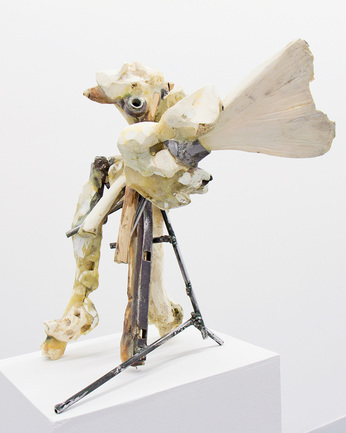-
From Current Issue
-
- Editor’s Letter Fire in the Heart
- Reviews I Gusti Ayu Kadek Murniasih
- Reviews 11th Seoul Mediacity Biennale: “One Escape at a Time”
- Dispatch Networked China
- One on One Monira Al Qadiri on Yukio Mishima
- Essays The rise of independent art spaces in pandemic-era Shanghai
- Features Tuan Andrew Nguyen
- Table of Contents
- Web Exclusives
- Archive
- Subscribe

R
E
V N
E
X
T
Installation view of YASUE MAETAKE’s “Transmutations,” at Microscope Gallery, New York, 2021. All images courtesy the artist and Microscope Gallery.
Tokyo-born sculptor and videographer Yasue Maetake studied glass art in Japan plus glass art and architecture in the Czech Republic before moving to New York, where she is now based, to obtain her MFA at Columbia University in 2006. Establishing a reputation for combining natural and industrial materials in unconventional ways, she quickly gained attention through the exhibition of her artworks, including at the 2008 Sonsbeek in the Netherlands, and more recently, at the 58th Venice Biennale at the Palazzo Benzon in 2019. Her solo show at New York’s Microscope Gallery, “Transmutation,” features 11 freestanding and tabletop sculptures from two recent series, Symbolic Atmosphere (2019) and Lineal Fetishism (2020). The presentation highlights the artist’s ongoing interests in animism, the Mono-ha movement’s direct use of “things,” and the Baroque, while spotlighting her skills in welding, sanding, and degrading materials to create dynamic pieces.
Abstractly referencing architectural structures, mountainous landscapes, and figures in motion, Maetake poetically combines animal bones (cow, pig, and camel—depending on the shape needed), seashells, rocks, resin, and metals in her handcrafted analog assemblages. Symbolic Atmosphere l, comprising cut and welded steel rods and shelf posts supporting an assortment of fragmented bones and carved wood, was fused together with epoxy clay to construct a bizarre, bird-like beast. Symbolic Atmosphere V, however, employs broken pieces of marbleized granite as an armature for scraps of merged metal, bone, and wood, resulting in a whimsical, Frank Gehry-like contorted construction, but at a more modest scale.
Symbolic Atmosphere lll’s expanding accumulation of cut and sanded bones, resting on a foundation forged from bits of welded steel, brings to mind designer Pierre Cardin’s surreal 1970s Bubble House near Cannes—designed by modernist architect Antti Lovag and comprising clusters of interconnected bubble-shaped spaces. Meanwhile, Symbolic Atmosphere Vl is somewhat more ornamental. A gateway piece, which anticipates the Lineal Fetishism series that follows, the decorative construction flaunts shiny brass plumbing spikes that recall the gilded rays illuminating Gian Lorenzo Bernini’s acclaimed marble sculpture, The Ecstasy of Saint Teresa (1647–52). Though Maetake admires the late Italian master and his work, the inspiration that she draws from The Ecstasy produces a surprisingly different result—one that fixates on the materials rather than the saint.
Taking the more Baroque character of Symbolic Atmosphere Vl as the point of departure for Lineal Fetishism l, Maetake began the piece by welding together alternating strips of polished copper and brass, which served as a base for the growth of bones, seashells, steel, cotton pulp, and synthetic clay on top. A fetishistic accumulation of monochromatic materials, the sculpture displays the movement and forms conveyed in another Bernini marble masterpiece, Apollo and Daphne (1622–25), which captures the pursuit of the nymph Daphne by the Greek god Apollo. Daphne escapes Apollo’s passion by asking the river god Peneus to transform her into a laurel tree, becoming one with the earth. Bernini’s depiction parallels animism, as does Maetake’s marriage of organic and manmade materials.
Installation view of YASUE MAETAKE’s Lineal Fetishism I, 2020, assorted animal bones and seashells, steel, brass, copper, cotton pulp, synthetic clay, 76.2 × 111.8 × 61 cm, at “Transmutations,” Microscope Gallery, New York, 2021.
Further into the gallery, Lineal Fetishism lll couples the animal and the industrial in a straightforward yet more complex manner. Placing a brass pipe welded from pieces of degraded piping through a hole cut into a large camel bone, at an angle to unite the two, the pipe acts like a flowing river or a waterfall descending from a mountaintop. Alternatively, Lineal Fetishism ll—a lively assemblage of metal, bones, stones, and seashells—suggests a different landscape that recalls the peculiar geometric structures populating the surrealist landscapes of Yves Tanguy. An exquisite mass of incongruent materials, Lineal Fetishism ll epitomizes the very idea of a contemporary fetish, an object that possesses the essence of its magical materials.
Continuing traditions of Mono-ha artists by exploring the encounter of natural and industrial materials, Maetake’s non-specific objects are born from both formal and cultural concerns. Seen through a surreal lens, however, they are substances longing to become something else—growing into a life form that’s futuristic and yet as old as time.
Paul Laster is a New York desk editor of ArtAsiaPacific.
Yasue Maetake’s “Transmutation” was on view at Microscope Gallery, New York, from January 29 to March 19, 2021.
To read more of ArtAsiaPacific’s articles, visit our Digital Library.















